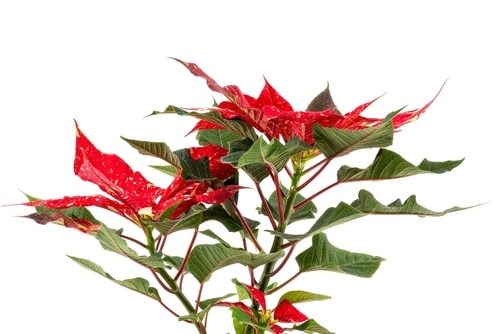Poinsettias are small wild deciduous shrubs native to Mexico, but for most of us, it is famous as holiday plant. It has shiny, dark green leaves with inconspicuous flowers that blossom in winter.
This flowering shrub grows to a height of about 10 feet and a width of about 6 feet. They are quite drought tolerant and can survive long periods without water. However, they will not flower well if they are not watered regularly.
How Much Water Do Poinsettias Need?
If you are a beginner at planting a poinsettia, you might wonder how often to water poinsettias? The answer is not as complicated as it seems. These plants need watering only when the soil feels dry to the touch, which is usually once a week. However, during the blooming season (winter), they will need to be watered more frequently, about 2-3 times a week.
When watering, ensure the water reaches the roots and not just the leaves. Water the soil until it is saturated and let the excess water drain out. Do not water again until the soil feels dry to the touch. Overwatering will cause the leaves to turn yellow and drop off, so be careful not to overwater.
How to Water Plotted Poinsettias?
When watering poinsettias in pots or containers, it is vital to check if the plant pot has drainage holes. If it does not have any, drill some holes into the bottom of the pot to allow for proper drainage.
Fill the container with water until the soil is saturated, and let the water drain out completely. Do not water again until the soil feels dry to the touch. Be careful not to overwater as this will cause the roots to rot.
In addition, a plotted poinsettia will thrive if you do not incorporate a decorative foil. This decorative foil will hold in moisture and will not allow the water to drain, leading to overwatering.
When to Water Poinsettias?
One of the most important things to remember when caring for a poinsettia is vital not to let the plant stand in water. The best way to water a poinsettia is to give it a good soaking and then let it dry out completely before watering again. Touching the topsoil if it is dry-to-touch is a good indicator that it is time to water the plant.
If you live in an area with high humidity, you might need to water your poinsettia more frequently as the air will make the soil moist faster. Conversely, if you live in a dry climate, you might need to water your plant less often.
What Type of Water Should Be Used to Water Poinsettias?
Ideally, the target range for the pH level of the water should be 5.8 to 6.2. This is the optimal level for plant growth. If you are using city water, it is likely that the pH level is already in this range.
If you are using well water, you will need to have your water tested to ensure the pH level is within the target range. If it is not, you can use a water softener to adjust the pH level of your water.
Signs That Your Poinsettias Are Overwatered
The first sign that your poinsettia is overwatered is when the leaves start to turn yellow and drop off. If you see this happening, it is important to stop watering immediately and let the plant dry out completely. Once the plant has dried out, you can resume watering but be sure not to overwater again.
Other signs that your poinsettia is overwatered include wilting leaves, stem rot, and root rot. If you see any of these signs, it is important to take action immediately and stop watering the plant. Allow the plant to dry out completely and then resume watering with caution.
Signs That Your Poinsettias Are Underwatered
If your poinsettia is not getting enough water, the first sign you will notice is the leaves starting to droop. The leaves will also start to turn brown and crispy. If you see these signs, it is important to water your plant immediately.
Other signs that your poinsettia is thirsty include wilting leaves and stems. If you see any of these signs, water your plant immediately, and be sure to increase the frequency of watering.
Final Thoughts
Caring for a poinsettia is not difficult, but there are a few things to keep in mind to ensure that your plant thrives. Be sure to water your poinsettia regularly, but do not overwater, as this can lead to root rot.
It is also important to use the proper type of water and to fertilize your plant regularly. If you notice the leaves starting to droop or turn yellow, this is a sign that your plant needs more water.

